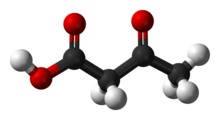
Back حمض أسيتو الأسيتيك Arabic اسید استواستیک AZB Àcid 3-oxobutanoic Catalan Kyselina acetyloctová Czech Acetoeddikesyre Danish Acetessigsäure German Aceto-acetata acido Esperanto Ácido acetoacético Spanish اسید استواستیک Persian Asetoetikkahappo Finnish

| |

| |
| Names | |
|---|---|
| Preferred IUPAC name
3-Oxobutanoic acid[1] | |
| Systematic IUPAC name
3-Oxobutyric acid | |
| Other names
Acetoacetic acid
Diacetic acid Acetylacetic acid Acetonecarboxylic acid | |
| Identifiers | |
3D model (JSmol)
|
|
| ChEBI | |
| ChEMBL | |
| ChemSpider | |
| DrugBank | |
| KEGG | |
PubChem CID
|
|
| UNII | |
CompTox Dashboard (EPA)
|
|
| |
| |
| Properties | |
| C4H6O3 | |
| Molar mass | 102.089 g·mol−1 |
| Appearance | Colorless, oily liquid |
| Melting point | 36.5 °C (97.7 °F; 309.6 K) |
| Boiling point | Decomposes |
| Soluble | |
| Solubility in organic solvents | Soluble in ethanol, ether |
| Acidity (pKa) | 3.58[2] |
Except where otherwise noted, data are given for materials in their standard state (at 25 °C [77 °F], 100 kPa).
| |
Acetoacetic acid (IUPAC name: 3-Oxobutanoic acid, also known as Acetonecarboxylic acid or Diacetic acid) is the organic compound with the formula CH3COCH2COOH. It is the simplest beta-keto acid, and like other members of this class, it is unstable. The methyl and ethyl esters, which are quite stable, are produced on a large scale industrially as precursors to dyes. Acetoacetic acid is a weak acid.[3]
- ^ "Front Matter". Nomenclature of Organic Chemistry : IUPAC Recommendations and Preferred Names 2013 (Blue Book). Cambridge: The Royal Society of Chemistry. 2014. p. 748. doi:10.1039/9781849733069-FP001. ISBN 978-0-85404-182-4.
- ^ Dawson, R. M. C., et al., Data for Biochemical Research, Oxford, Clarendon Press, 1959.
- ^ Cite error: The named reference
Ullmannwas invoked but never defined (see the help page).